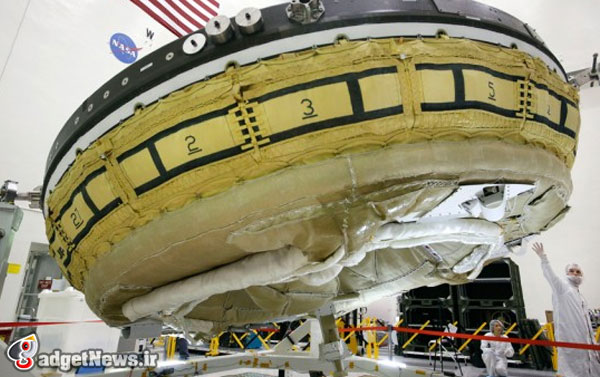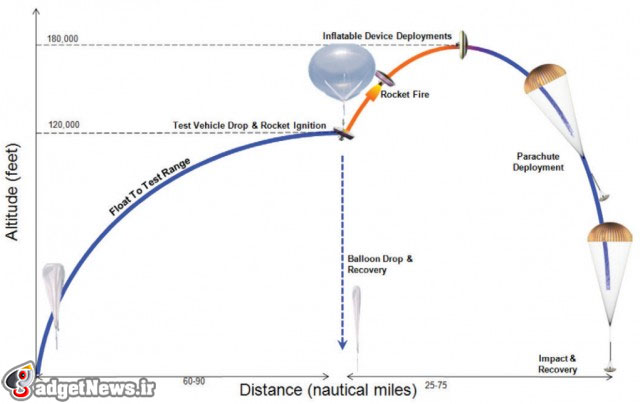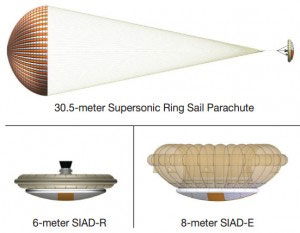
همگی تصاویری از پرواز بشقاب پرندههای عجیب و غریب را در اینترنت دیدهایم ، تصاویری که البته اغلب آنها به شکل ناشیانهای تقلبی هستند و البته تعداد بسیار زیادی از آنها به شکل حرفهای باورپذیر!
حال این بشقاب پرندهها واقعی باشند یا غیرواقعی، ناسا قصد دارد به زودی وسیلهای با ظاهر بشقاب پرنده را تست کند که از آن برای نقل و انتقال و فرود جستجوگرانی بزرگتر از کنجکاوی ( Curiosity ) بر روی سطح سیارهها استفاده خواهد کرد. این پروژه که با نام اختصاری LDSD معرفی شده، به منظور فرود محمولههای بسیار سنگین بر روی سیارهها مانند مریخ در حال طراحی است و احتمال دارد سال 2018 مورد بهرهبرداری قرار گیرد.

تست اولیه و واقعی LDSD قرار است در ماه ژوئن و در یکی از تأسیسات متعلق به نیروی دریایی آمریکا در هاوایی انجام شود. فناوری کنونی فرود محمولهها در فضا مربوط به دهه 70 میلادی و پروژهی وایکینگ است که دو جستجوگر را در سال 76 روی مریخ نشاند و 35 سال بعد نیز برای بار دوم کنجکاوی ( Curiosity ) را به سلامت روی مریخ فرود آورد. فناوری جدید قرار است جایگزین روش قدیمی شود تا درهای بیشتری را به روی دانشمندان ناسا برای ارسال محمولههای سنگنینتر و قویتر باز کند.

ناسا برای آزمایش فرود آرام و امن اين فضاپیما که قرار است بر روی سطح مریخ فرود بیاید، از پاراشوت یا چتر نجات سوپرسانیک استفاده میکند.
اگر اخبار مریخنورد کنجکاوی و فرود حساس آن روی مریخ در سال 2012 را دنبال کرده باشید، حتماً چتر نجاتی که ناسا برای کند کردن فرآیند فرود استفاده کرده را به خاطر دارید ، آن چتر نجات کوچک برای اجسام سنگینتری که در آینده قرار است به مریخ سفر کنند، مناسب نیست. لذا ناسا مدلی بزرگتر به نام کندکنندهی سوپرسانیک کمتراکم برای LDSD را ساخته که بسیار بزرگ است. برای آزمایش آن هم نمیتوان از تونلهای باد کوچک استفاده کرد. لذا یکی از آژانسها تونل باد بزرگی برای آزمودن این چتر نجات ساخته است.
نوآوری ناسا در این بوده که از المانهای مختلفی شامل یک بالگرد عظیمالجثهی Night Hawk، صدها پوند وزن، وینچ و راکتها و مقدار زیادی طناب استفاده کرده است. آزمون نهایی بسیار مشکل بوده و در نهایت بخشی از پاراشوت پاره میشود. اما در نهایت این یک آزمون بزرگ است و نتیجه هر چه باشد، یک موفقیت محسوب میشود.
منبع : extremetech
Meet NASA’s new supersonic flying saucer, for future Mars landings
No, humble inhabitants of Hawaii, the US government hasn’t increased the level of psychoactive drugs in your water supply: That really is a flying saucer that just flew past your window at three times the speed of sound. Dubbed the Low-Density Supersonic Decelerator, NASA is hoping that this flying saucer is the secret to eventually landing larger payloads on other planets — such as sending a human exploration party to Mars, along with plenty of supplies. The LDSD is on a pretty aggressive schedule, with seven major tech demos over the next 24 months, and could be used in a real mission to Mars in 2018.
Later this year, NASA’s Jet Propulsion Laboratory will use a balloon to launch a test vehicle up to an altitude of 120,000 feet (36.5 kilometers) above Hawaii. The test vehicle will then use a rocket to reach supersonic speeds and raise its altitude yet further to 180,000 feet (54.8 kilometers)… and then it will cut its engine and begin to free fall back to earth. As the capsule passes Mach 3.5 (2,600 mph), the LDSD will kick into action, sprouting a Supersonic Inflatable Aerodynamic Decelerator (SIAD) from the craft and filling it with pressurized air. With the SIAD fully inflated, the spacecraft looks awfully like a flying saucer. The SIAD slows the craft down to around Mach 2, whereupon a massive 30-meter-diameter parachute will then be used to bring speeds down to subsonic landing speeds.
NASA is developing two variants of the LDSD [PDF] – one with a 20-foot (6m) SIAD for smaller, robotic extraplanetary landings, and one with a larger 26-foot (8m) SIAD for larger, human payloads. The overall goal of the LDSD is to make it possible for NASA to land larger payloads on the surface of Mars: While the parachute-to-sky-crane technique used by Curiosity was technologically impressive, the sky crane simply isn’t capable of landing payloads over 1.5 metric tons (3,300 lbs). The LDSD will not only allow NASA to land payloads of up to 3 tons on Mars, but it will also increase the number of possible landing zones and improve landing accuracy from a margin of 10 kilometers (6.2 miles) to just 3km.
While our mastery of Newtonian physics means it’s fairly trivial to place a place a spacecraft in orbit around any planet in the Solar System, landing on a planet or moon’s surface is still incredibly difficult. Every moon and planet in the Solar System has different atmosphere, gravity, and surface conditions, and thus each mission needs to have a specifically tailored landing procedure. For Mars, the difficulty is that it has too much atmosphere for rapid entry and rocket deceleration (as we did with the Moon landings), but it doesn’t have enough atmosphere to land large objects with only a parachute. (Here on Earth, with our deliciously thick atmosphere, we’ve used parachutes to land masses of up to 72,000 lbs or 32.5 metric tons).
Thus, if we ever want to send a human exploration party to Mars, or eventually colonize it, we need to use a hybrid landing technique — something with a rugged first stage to take the initial brunt of interplanetary deceleration, and then a big ol’ parachute to bring you down to ground-approach speeds. Small rockets would probably be used for final landing maneuvers. Currently, we still use the original parachute design used by the Viking lander program in the ’70s, so it’s definitely time for an upgrade. (Read: US Air Force’s 1950s supersonic flying saucer declassified.)
NASA is scheduled to perform a series of LDSD launches from the Pacific Missile Range Facility on Kauai, Hawaii in 2014 and 2015. The LDSD could be ready for missions to Mars as early as 2018, though there aren’t currently any scheduled heavy-payload missions to Mars that could use it. For now, we’ll just have to settle with NASA’s flying saucers whizzing around on Earth.
 گجت نیوز آخرین اخبار تکنولوژی، علم و خودرو
گجت نیوز آخرین اخبار تکنولوژی، علم و خودرو 





